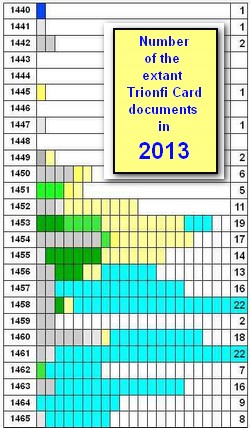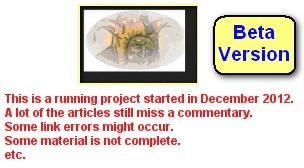Bartolomeo di Paholo Serragli (active 1453-1458)
composed by Lothar Teikemeier, last update 06.12.2012
|
First recorded Trionfi card activity with Filippo di Marco: 1453-03-10 Last recorded Trionfi card activity with Filippo di Marco: 1458-04-01 Activities with Giovanni di Domenico: in September 1455 |
|
Sources
Sources are mainly taken from Franco Pratesi's new article series written from November 2011 till now, published here at Trionfi.com.| SOURCE 1: Bartolomeo Serragli, active 1453-1458 |
|
Quote from Franco Pratesi: "1453-1458 Florentine triumphs by Filippo di Marco", 12.01.2012 |
Bartolomeo SerragliFirst of all, we have to understand the function of Bartolomeo Serragli in this trade, and for this we can directly use the "explanation" provided in the article.
This dealer was particularly active towards the South of Italy, down to Naples and its royal palace. Some comments can be added now. Interesting enough is that these particular cards were of various qualities and values. Together with rather cheap items, we find pricey ones: remarkable among them is the first pack encountered, in 1453. One could simply conclude that at this rather early time it was still a new and costly kind of production, but also the contrary opinion can easily be supported: the very fact that this pack was indicated as unusually rich may prove that more current ones existed already.
Rather astounding may be the fact that just in one case can "simple" playing cards be found as manufactured and acquired. We had rather expected the contrary situation, in which ordinary cards were the rule and triumphs the exception. Apparently, triumphs were precisely the kind of playing cards most looked for, at the time, in this particular kind of trade. |
|
Repeated Note: When Ross Caldwell and me in 2003 started to collect Trionfi notes between 1442-1463, we had about 27/28 entries (which I nowadays would count as 31). The major part were the documents of Ferrara, which were collected by Gherardo Ortalli and Adriano Franceschini in the "Prince and the Playing Cards" (1996), after the base laying works of Michael Dummett and Stuart Kaplan around 1980. This collection included 2 notes about Trionfi cards in Florence, found by Franco Pratesi in his earlier work (allowances of the Trionfi game in 1450 and 1463). A graphical representation of this time (with 27 entries) shows the dominance of Ferrarese documents (in black) with a few notes only from other locations (in red; see picture to the right) In the period 2004 till October 2011 it was possible to add 4 further notes (Siena 1452, Padova 1455, Ancona c. 1460 and Valerio Marcello c. 1460), mainly thanks to information given by Thierry Depaulis. Franco Pratesi started his new article series in November 2011. Since then the list has gotten 67 new documents till September 2012 (65 of them found by Franco Pratesi, one, now the oldest of September 1440, by Thierry Depaulis, and another one by Veber Gulinelli, who controlled the earlier work of Franceschini and found an overlooked document) and nearly all are related to Florence or its surrounding. A small book (118 pages) was published around Christmas 2012, Franco Pratesi: "Playing Card Trade in 15th Century Florence" as IPCS Paper No. 7 (ISSN 0305-2133). It contains some of the articles, which before had appeared at this website, those, which treat the early time of 15th century. Thierry Depaulis commented in his foreword: "This book is a landmark in the history of early playing cards in Italy". Well, maybe not the book, but the research is clearly a landmark in various interests. For the collection of early Trionfi notes it somehow means, that we have within the year 2012 about 200 % more data for the period 1440-1462 than mankind had collected in the 200 years before. Added later: In August 2013 the new report of Arnold und Doris Esch: "Aus der Frühgeschichte der Spielkarte. Der Import von carte da giocare und trionfi nach Rom." in Gutenberg Jahrbuch 2013, 88. Jahrgang, p. 41-53, arrived in our redaction. It contains 106 new references to Trionfi decks, which all were found in the customs registers of the city Rome for the period 1453-1465. With this the number of all earlier Trionfi cards records has been doubled and should have reached then c. 210 (from which a few are only considered to be "Trionfi card notes" and don't contain the word "Trionfi" or something similar). *********** I'd started to sort the new Trionfi card documents overview in October 2012. Articles will be possibly changed according improvements in research. |
|


